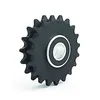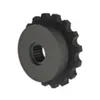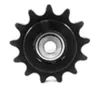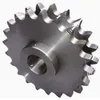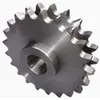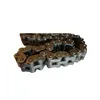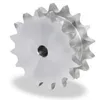Chain and sprockets are mechanical components used to transmit power and motion between rotating shafts. They work together in systems where precise, efficient, and reliable power transfer is essential, such as in industrial machinery, automotive applications, bicycles, and conveyor systems. The chain, typically made of metal links, engages with the teeth of the sprocket to drive movement, offering high durability and resistance to slipping compared to belt drives.
Chains and sprockets are manufactured from various materials to suit different environments and loads. Common materials include:
Understanding the technical specifications is crucial for selecting the right chain and sprocket for your needs. Below are the key parameters presented in lists and tables for clarity.
| Chain Type | Pitch (inches) | Width (inches) | Tensile Strength (lbs) | Common Applications |
|---|---|---|---|---|
| Roller Chain (ANSI 40) | 0.5 | 0.312 | 3,700 | Industrial machinery, conveyors |
| Roller Chain (ANSI 60) | 0.75 | 0.469 | 8,500 | Heavy-duty equipment, automotive |
| Silent Chain | 0.375 | 0.5 | 6,000 | High-speed precision drives |
| Leaf Chain | 0.75 | 0.75 | 12,000 | Forklifts, lifting applications |
| Sprocket Type | Number of Teeth | Pitch (inches) | Bore Size Range (inches) | Material |
|---|---|---|---|---|
| ANSI 40 Sprocket | 10-60 | 0.5 | 0.5-2.0 | Steel, Stainless Steel |
| ANSI 60 Sprocket | 10-80 | 0.75 | 0.75-3.0 | Heat-Treated Steel |
| Double Pitch Sprocket | 12-72 | 1.0 | 1.0-4.0 | Cast Iron, Steel |
| Idler Sprocket | N/A | 0.5-1.0 | 0.5-2.5 | Nylon, Steel |
Proper installation and maintenance extend the life of chain and sprocket systems. Key steps include:
What is the difference between a chain drive and a belt drive?
Chain drives use metal chains and sprockets for power transmission, offering higher strength, durability, and efficiency in harsh environments, but they require more maintenance and are noisier. Belt drives use rubber or polymer belts and pulleys, providing quieter operation and better for applications where slippage might be beneficial, but they are less durable under heavy loads.
How do I choose the right chain and sprocket for my application?
Consider factors like load capacity, speed, environment (e.g., exposure to moisture or chemicals), and desired lifespan. Calculate the pitch based on the torque and speed requirements, select the chain type (e.g., roller chain for general use, leaf chain for lifting), and match the sprocket teeth count to achieve the required gear ratio. Always refer to manufacturer specifications for compatibility.
What causes chain and sprocket wear, and how can I prevent it?
Wear is caused by friction, misalignment, inadequate lubrication, overloading, and environmental factors like dirt or moisture. To prevent it, ensure proper installation with aligned sprockets, use high-quality lubricants regularly, avoid exceeding load limits, and implement routine inspections to catch early signs of wear such as chain elongation or tooth deformation.
Can I mix chains and sprockets from different manufacturers?
It is not recommended. Chains and sprockets are designed to precise specifications, and mixing brands can lead to compatibility issues, increased wear, and reduced efficiency. Always use matched sets from the same manufacturer or ensure they meet identical standards (e.g., ANSI or ISO ratings) to guarantee optimal performance and safety.
How often should I lubricate my chain drive system?
Lubrication frequency depends on the operating conditions. For standard industrial applications, lubricate every 8 hours of operation or as specified by the manufacturer. In high-temperature, dirty, or wet environments, more frequent lubrication may be necessary. Use a lubricant suitable for the chain material and conditions, such as heavy-duty oil for steel chains in dusty areas.
What are the signs that my chain and sprocket need replacement?
Look for visible wear like rust, cracks, or elongated links in the chain (measure pitch length; if it has elongated by 3% or more, replace it). For sprockets, check for hooked or worn-down teeth. Unusual noises, vibration, or slippage during operation are also indicators. Regular maintenance logs can help track wear over time and plan replacements proactively.


